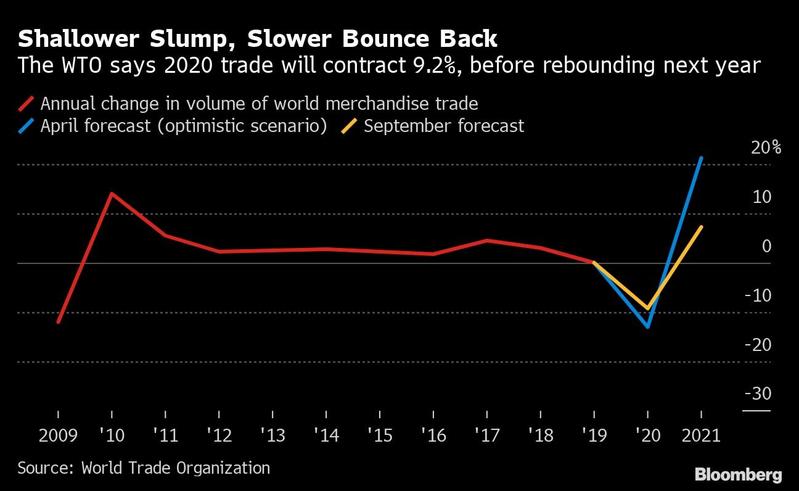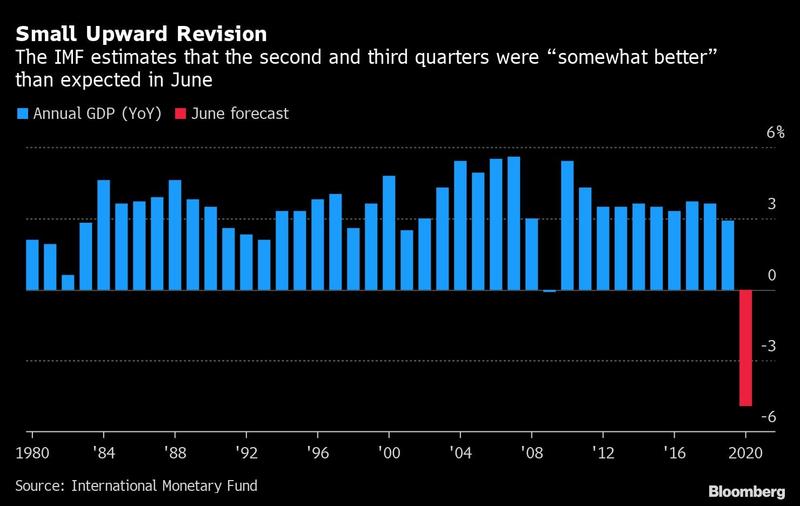
BRUSSELS - Two custodians of the global economy signaled that while the early days of pandemic recovery were stronger than expected in some countries and industries, a return to full health is likely to be longer and bumpier than they first predicted.
The World Trade Organization said it expects global merchandise trade to fall by 9.2 percent this year from 2019, compared with the 12.9 percent drop projected in April, according to revised forecasts released Tuesday in Geneva. But the WTO also said it expects global trade growth of 7.2 percent in 2021, much weaker than the prior outlook for a 21.3 percent bounce-back.
That outlook jibes with the view of the International Monetary Fund, which Managing Director Kristalina Georgieva said Tuesday will make a “small upward revision” to its 2020 global growth forecast next week and warn that the rebound may take at least a year longer.
The WTO warned that the current forecast could slip if there’s a resurgence of coronavirus cases in the fourth quarter or if nations resort to trade protectionism
“We expect global output to remain well below our pre-pandemic projections over the medium term,” she said. “For almost all countries, this will be a setback to the improvement of living standards.”
A deeper trade slump has been avoided this year, the WTO said, because of a surge in cross-border commerce in June and July after lockdowns were lifted, medical supplies met with strong demand and global economic activity accelerated.
READ MORE: WTO gives somber goods trade outlook, sees virus threat
The WTO warned that the current forecast could slip if there’s a resurgence of coronavirus cases in the fourth quarter or if nations resort to trade protectionism. The more sluggish rebound means global trade will remain below its pre-pandemic trend through 2021, it said.
“Worse outcomes are still possible if there is a strong resurgence of the COVID crisis in the coming months,” Deputy Director-General Yi Xiaozhun said during a press conference in Geneva. “One of the greatest risks for the global economy in the aftermath of the pandemic would be a descent into protectionism.”
The projections come as the summer’s nascent rebound in economic activity has begun to cool with the emergence of a second wave of infections in parts of Europe and the US.

Europe has struggled to keep the pandemic in check and COVID-19 cases in Germany are rising by the most since the initial wave hit in April. The UK government, meanwhile, has urged workers to stay home and announced tougher restrictions aimed at preventing an acceleration of infections.
US recovery
The pace of America’s economic recovery is flagging, too, as job growth slowed and the virus spreads across much of the country. The economic pain may continue as long as US lawmakers remain at loggerheads over a fresh government aid package.
ALSO READ: WTO cuts outlook for global trade growth to lowest in 10 yrs
The WTO said monetary and fiscal policies have helped prop up incomes and allowed consumption and imports to rebound once lockdowns were eased.
“Fall and winter holds a lot of uncertainty,” WTO Chief Economist Robert Koopman said.
“Asian exports have been strong but for those exports to be maintained you need strong demand,” he said. “Much depends on government stimulus.”
The 14.3 percent drop in global merchandise trade in the second quarter of 2020 marked the sharpest decline since the WTO began keeping records in 2005. The steepest drops were in Europe, where exports fell 24 percent, and in North America, which saw a 21.8 percent plunge.
Trade in most manufactured goods bottomed out in April before starting to recover in May and June, according to the report. Exports of automobile products saw the largest decline of all goods -- a 70 percent drop in April -- due to supply disruptions and a lack of consumer demand.
Meanwhile, exports of personal protective equipment saw a surge in growth, recording a 92 percent increase in the second quarter and a 122 percent increase in May, the WTO said.
“The decline would have been worse if COVID-19 was deadlier and governments had not acted to stem its spread,” WTO Senior Economist Coleman Nee said.


